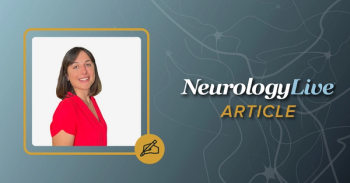
sTMS: Promising Migraine Therapy
Transcranial magnetic stimulation is a promising, effective, well-tolerated and safe treatment option for migraine with and without aura, episodic or chronic.
Migraine is a primary headache disorder that affects over 1 billion worldwide.1 Despite its prevalence, there are a small number of treatment options, each with side effects and contraindications. Recently, single-pulse transcranial magnetic stimulation (sTMS)-a novel nonpharmacologic, well-tolerated, and safe therapy-has shown promise for the treatment of migraine.
The sTMS device (Figure) works via an external stimulator placed behind the occipital aspect of the head; it is activated by a single click for acute treatment of migraine attacks. When fired, it creates a 0.9T 180ms magnetic pulse that induces an anticlockwise flow of current at the target area cortex. In initial animal models, sTMS has been shown to block cortical spreading depression (CSD)2-the underlying pathophysiology in migraine aura and possibly migraine without aura. Additionally, sTMS may lead to long term modulation of cortico-thalamic activation as well as evoked activity in the sensory thalamus that occurs after CSD.3 These potential mechanisms may explain how sTMS may be effective as not only an acute treatment option, but also a preventive option for migraine.
The first large clinical trial evaluating sTMS treatment in migraine was a randomized, double-blind, sham-controlled multicenter trial of 267 adults with episodic migraine with aura.4 Participants met international criteria of headache disorders II (ICHD-II) criteria for episodic migraine with aura and had visual aura before 30% of their attacks. Individuals were excluded with medication overuse headache, prolonged (>60 min) aura, history of seizure or presence of metal with in the head or neck.
After a phase 1 run in period, a remainder 201 individuals were randomized to either sham or treatment stimulation devices. The sham device was said to be identical in appearance and created an equivalent discharge sound. Adequate blinding was confirmed on a post study survey where 67% of sham and 72% of active participants believed they had received active treatment. The participants were instructed to use the device at the onset of aura consisting of 2 treatments 30 seconds apart. Up to 3 attacks were to be treated and rescue medication was allowed 2 hours after treatment if needed.
The primary end point was pain freedom at 2 hours. 39% of treatment group was pain free at 2 hours as compared to 22% for sham stimulation (p=0.0179, 95%CI 3-31%). Additionally 29% of participants in the active group remained pain free at 24 hours compared to 16% in the sham group. No significant adverse events were reported.
The authors concluded that sTMS was a promising option for the acute treatment of migraine with aura. A subsequent comparison of sTMS response versus acute treatment with triptans showed a similar total migraine freedom rate at 2 hours5 and a much better side effect profile.
The device received FDA approval for the acute treatment of migraine with aura in December 2013,6 but is not yet currently available for clinical use in the US pending further study.
sTMS is currently undergoing evaluation as a preventive option for migraine with and without aura. In an open label post-market study recently presented at an American Headache Society meeting, sTMS of two pulses twice to three times daily in addition to use as acute treatment was associated with reduction in headache days after 12 weeks of treatment without serious adverse events. In a population (n=122) comprising both chronic and episodic migraine with and without aura, 72% reported that sTMS use reduced pain.7 An exciting finding was that headache day reduction was more prominent in the chronic migraine group-an often difficult-to-treat population. A large multi-site observational study, the eNeura Spring TMS post-market observational study of migraine or ESPOUSE Study, is underway to further to examine the potential preventive and acute treatment effects in both episodic and chronic migraine.
Bottom line: sTMS is a promising, effective, well-tolerated and safe treatment option for migraine with and without aura, episodic or chronic.
References:
1. Years lived with disability (YLDs) for 1160 sequelae of 289 diseases and injuries 1990-2010: a systematic analysis for the Global Burden of Disease Study 2010.
2. Holland PR, Schembri C, et al. Transcranial magnetic stimulation for the treatment of migraine aura? Cephalalgia. 2009;20(Suppl 1):22. (PO29).
3. Andreou AP, Sprenger T, et al. Cortical modulation of thalamic function during cortical spreading depression- Unraveling a new central mechanism involved in migraine aura. J Headache Pain. 2013;14(Suppl 1):I6.
4. Lipton RB, Dodick DW, et al. Single-pulse transcranial magnetic stimulation for acute treatment of migraine with aura: a randomized, double-blind, parallel-group, sham-controlled trial.
5. Starling AJ, Bravo TP, et al. Total migraine freedom (TMF) for single pulse transcranial magnetic stimulation (sTMS) versus triptans for the early acute treatment of migraine. Cephalalgia. 2013;33(suppl 8):30. (P14).
6.
7. Bhola R, Kinsella E et al. Update of the UK post market pilot programme with single pulse transcranial magnetic stimulation (STMS) for the acute treatment of migraine. J Headache Pain. 2014;15(Suppl 1):M2.
Newsletter
Keep your finger on the pulse of neurology—subscribe to NeurologyLive for expert interviews, new data, and breakthrough treatment updates.




























